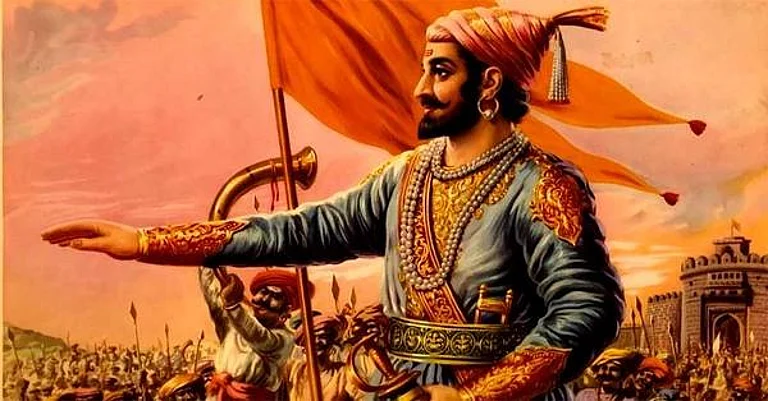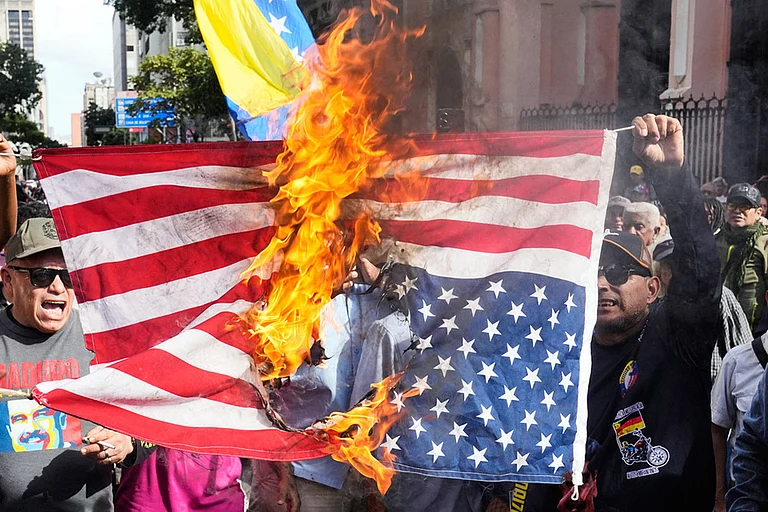Generations of people in Assam and the Northeast have grown up with stories about the legendary valour of Lachit Barphukan, a military general who had led the Ahom forces to victory in the decisive 1671 Battle of Saraighat against the mighty Mughal army of Aurangzeb. Around 350 years later, when the BJP set out to capture Assam, and subsequently the Northeast, the Battle of Saraighat became the leitmotif of its campaign. What the party did was to twist the story a bit to evoke nationalistic pride mixed with a religious angle. Overnight, Lachit Barphukan became a ‘Hindu’ general who defeated ‘Muslim’ invaders. What was consciously avoided was the fact that one of the most trusted lieutenants of Barphukan was a Muslim, Ismail Siddique, who was given the honorific title of ‘Bagh Hazarika’—bagh in Assamese is tiger. What was also not mentioned in the BJP’s retelling of history is that the Mughal forces were led by Raja Singh of Amber, a Rajput ally of Aurangzeb.
The BJP went on to win the 2016 assembly polls in Assam, the first time it managed to form a government in the state. The party now is in power in seven states of the Northeast—once a Congress fortress—either on its own or in alliance with other parties. In an ironic twist, the BJP did make history by revisiting history. All through its journey, the party plucked out local ‘icons’, most of them hardly known outside the region, and projected them as “national heroes” who had been ignored by previous governments. It successfully managed to play on the long-standing grievance among the people that the history of the Northeast had long been excluded from mainstream ‘Indian history’.
The common man and academicians agree on this point. More than 2,000 km away from Delhi in geographical distance, Northeast India—home to over 250 tribes and communities with over 200 languages and dialects—is still far from the popular imagination of mainland India. Other than using whatever little is found about the history of Northeast to fit the popular nationalistic perspective, the history of more than 45 million people in eight states—which were never annexed by the Mughals—has failed to attract post-colonial historians. “Post-colonial Indian history has largely been written keeping in mind the broader political interests of the nation-state. Within such a perspective, the Northeast has always been the political and cultural ‘other’ which doesn’t really fit into the political imagination of the nation,” says John Thomas, a historian and assistant professor of history at the Department of Humanities and Social Sciences in IIT Guwahati. “If at all the Northeast is mentioned in Indian history, it has only been in reference to the anti-colonial struggle against the British,” Thomas tells Outlook.

It would not be surprising if a majority of the people in the region—even those who don’t subscribe to right-wing ideology—find no fault in the BJP-led central government’s move to rewrite Indian history from an “Indian perspective”. Till a few years ago, textbooks of national boards barely had any reference to Ahom history, despite the fact that the dynasty’s reign spanned 600 years, the longest by any dynasty in India. History of other states in the region were totally absent. All that “Indian history” featured from the region was passing mention of contribution to the freedom movement. What was never discussed in detail was the life and struggles of Kanaklata Baruah of Assam, or Paona Brajabashi from Manipur, or U Tirot Sing Syiem from Meghalaya and Rani Gaidinliu of Manipur—all of who are icons in their respective states but hardly known beyond the Chicken’s Neck, the thin strip of land that connects Northeast with mainland India.
A few days back, Union home minister Amit Shah made a case for rewriting history by referring to the rule of Ahoms, among many other local kingdoms. “The Ahom dynasty ruled Assam for 600 years. From Bakhtiyar Khalji to Aurangzeb they defeated everyone and kept Assam sovereign…We need to keep these accounts in front of the people and reference books need to be written about them. We think the wrong will fade away and the truth will be known.”
Othering of Northeast
On May 22, Rajon Das, a 22-year-old engineering student from NIT, Silchar, embarked on a walk through all NE states demanding inclusion of chapters on history of the region in the national educational curriculum. “NCERT only has a supplementary book on Northeast history, which most students skip because they already have a huge load of primary study material,” Das says. “Until and unless NCERT includes the history of the Northeast as a primary subject, it is not going to help in raising awareness about the region, and Northeastern students will continue to face racism in other parts of the country. We know the history of India from Bengal to Kashmir, but how many know about Northeast India, its freedom fighters, the Anglo-Manipur war or even World War II in Manipur, for instance?” Das asks.

The exclusion of the tribes from the textual narratives of Indian history has resulted in a wide gap between mainstream India and the peripheral communities of the Northeast. And without proper understanding, the region has come to be stereotyped as a hub of insurgency, impregnable forests and ‘exotic’ tribes. This in turn has fuelled racism and hate crimes against people with Mongoloid features—their Indian identity questioned and ridiculed as Chinese. These crimes rose in numbers during the height of the Covid pandemic when many people from the northeastern states were assaulted, called ‘coronavirus’ and even spat on, as they were being blamed for spreading the virus which had its origins in China.
According to Dhiren A. Sadokpam, a political commentator from Manipur, the absence of a proper Northeast history as part of the collective Indian history widened the gap between the people of mainland India and the communities of the region. “Despite the highly-used slogan of ‘unity in diversity’, social, economic, and political asymmetry within the Indian Union is all too palpable…What is being taught in schools, colleges and universities was conspicuous by the total absence of the social, political, and economic histories of the peripheral states and people.”
Ignored past and identity crisis
Ignored in mainstream history and textbooks, the societal and cultural features, and the political understanding of the region remains a puzzle for Indian bureaucracy. This failure of the bureaucracy, many feel, has fuelled ethnic rebellions in the region. “History plays a critical role in this regard. Most of the communities in the region are oral in their social transactions. The tradition of history writing, on the other hand, is highly biased in favour of literary sources. Thus, the social memories of these oral communities do not pass the standard of evidence crucial for reconstruction of their pasts, turning them into ‘people without history’. This denial of their pasts is one of the reasons for the identity crisis among them leading to unrest,” says Uttam Bathari, associate professor in the Department of History in Gauhati University. “Thus, it is imperative to bring in change in the methods of writing history to understand and reconstruct the pasts of the oral communities.”

Though a large part of NE history is in oral form, there are also volumes of written indigenous chronicles, like the Buranjis of the Ahom kings, the Cheitharol Kumbaba, the royal documents of Manipur, and Rajmala, the royal chronicles of Tripura, all of which have records of Northeast’s history. Some of these accounts date back 2,000 years. Academics say it is important for Indian mainstream historians to give space to such rich accounts to make Northeast India’s tribes feel included in the idea of the nation. “Though several historians from the mainland have worked on various aspects of history of this region, still the Northeast as such does not figure in the national narrative. Frequent harassment faced by people from this region in various parts of India itself reflects the caste-ridden Indian attitude to this region. Absence of Northeast in the mainstream historical narrative is a reflection of this mentalite,” Bathari adds.
Ignoring the past of the region does have definitive fallout on peace-building measures undertaken to settle decades-old armed political violence in the region. Ignoring the past by those in the business of governing would further deepen the trust-deficit already kept afloat by years of negligence. According to Thomas, genuine peace-building can take place only when one goes to the roots of the problems that the region confronts. “History becomes handy in giving an insight to that. Recognising the particular history of the region is important in solving present issues and moving forward. Towards this end, there ought to be greater engagement between professional historians and bearers of oral and other historical traditions existing in the region.”
While the new attention to the history of the Northeast has been well received in the region, the enthusiasm of the ruling BJP needs a closer review. Thomas wonders whether the party and government are really interested in putting an effort to understanding and representing the nuances and complexities of the history of the region, or is it just an effort to integrate the region into the larger history of ‘Bharatvarsh’ by recasting historical events in a new form. “Historical figures get co-opted as nationalist leaders protecting an essentially Hindu nation. The history of Northeast India has been neglected for long by the nation, wherein it has become relatively easier for Hindutva to claim the region’s history for its own political ends,” he said.
The right-wing will perhaps find plenty of support to its cause in the Northeast but it will be interesting to see how far it can stretch Mughal invader theory and Hindu-Muslim binary in a region where at least three states are Christian-majority and others have indigenous faith systems. More importantly, none of these states, barring Assam, have ever faced Mughal invasion. For most in the Northeast, it’s not about rewriting history. It’s about their history being heard in mainland India. It is about not having to prove their Indianess over and over again.
Sometimes, history is also about the present.
(This appeared in the print edition as "Strangers of the Mist")


























